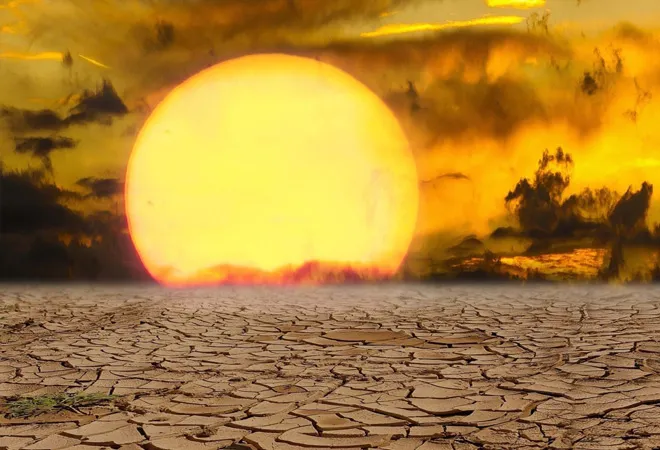-
CENTRES
Progammes & Centres
Location
This year’s theme for the Earth Day, ‘Invest in our planet’, is a pivotal point in history as the need to adapt and mitigate the triple planetary crisis intensifies

Adapting to the effects of climate change is no longer an option, it's a necessity to ensure a secure and sustainable future for ourselves and future generations. Among all climate extreme events, hot extremes such as heatwaves are increasing at a rapid rate in Asia, putting millions at risk. After a once-in-five-decade heatwave last year in March, 2023 is expected to continue the trend of sweltering summers in India. Although March 2023 began with locations such as Mumbai seeing heatwave warnings due to temperatures topping 39.4 degrees Celsius, unexpected cyclonic circulations and western disturbances lowered maximum temperatures over India with unseasonal rains and hailstorms. In March, rainfall in Central India exceeded of the long-period average (LPA), while it exceeded 100 percent in southern India. Additionally, updating its seasonal hot weather outlook, the Indian Meteorological Department (IMD) on 1 April issued a public bulletin, projecting that the summer is about to get worse with the maximum temperature rising above 48 degrees across India by May end. Additionally, it is projected that the above-normal heatwave days are likely to stretch over many parts of India such as Bihar, Jharkhand, Odisha, West Bengal, Maharashtra, etc. Cities are at the centre of this hot mess, with millions moving away from rural areas each year. Cities are becoming home to climate-vulnerable populations. Building climate-resilient cities and towns is now imperative to mitigate the increasing risks and to adapt to a worst-case-scenario future.
Rainfall in Central India exceeded of the long-period average (LPA), while it exceeded 100 percent in southern India.
Although there is no universally accepted definition for heat waves, The World Meteorological Organisation defines it as, “five or more consecutive days with maximum temperature exceeding the average temperature by 5 degrees Celsius or more”. While, in India, it is defined as the “maximum temperature of two stations in a region for at least two consecutive days reaching at least 40 degrees Celsius or more in plain areas and at least 30 degrees Celsius or more in hilly regions”; a severe heatwave warning is issued if the maximum temperature is above 6.4 degrees Celsius than normal or more than 47 degrees Celsius. According to the IMD's Climate Vulnerability and Hazard Atlas 2021, India suffered more than 130 days per year of disastrous heatwave days on average between 1969 and 2019. Additionally, the duration of heat waves over central and northwest India has increased by about five days. Despite the fact that the subcontinent has long experienced heatwaves, the current climate crisis is bringing them to unprecedented heights. In the worst-case scenario (RCP 8.5), according to studies, the frequency of summer heatwaves (April to June) will increase by three to four times by the year 2100. While it is also anticipated that the average hot extremes will roughly double in duration.
Increased heatwave vulnerability in urban areas
Urban areas are more greatly impacted by heatwaves compared to rural regions. The effects of these heatwaves are observed in various areas such as human health, economic activities, demand for resources like water and energy, and loss of biodiversity. The second decade of the 21st century witnessed increased extreme weather events in India, including record-breaking heatwaves in cities like Hyderabad, Delhi, Prayagraj, and Bhubaneshwar in 2015. Churu, a small town in the western state of Rajasthan, recorded temperatures exceeding 50 degrees Celsius in 2016, while Chennai faced a water crisis in 2018 due to prolonged drought and intense heat. In 2022, severe effects of heatwaves were observed in Delhi, Raipur, Hyderabad, Mumbai, and other urban areas, with the most vulnerable populations, such as those living in slum areas, being disproportionately affected. The big question is, are we adequately prepared to handle the worst hot extreme that is still to come while setting new records every year? What steps and actions must urban India take to lessen the negative effects on all ecosystems and safeguard business value chains?
The effects of these heatwaves are observed in various areas such as human health, economic activities, demand for resources like water and energy, and loss of biodiversity.
Nature has always provided a remedy for dealing with hot summers. Using water and trees together is essential for controlling the heat in cities. Urban climate adaptation efforts to extreme heat can be strengthened by using nature-based solutions (NbS), also known as ecosystem-based approaches. NbS will not only support green infrastructure, which is essential for improving urban resilience, but it will also provide numerous additional social, economic, and environmental benefits. Adopting NbS necessitates a systemic change in how cities are planned, policies are created, and infrastructure and green spaces are managed by urban governance. Three approaches will be needed in urban India to combat the stifling summer and address the impending threats naturally.
With the frequency, intensity, and duration of the silent disaster (heatwaves) increasing rapidly in Indian cities, it is imperative to rethink the way cities are managed, planned, and built. Therefore, redefining nature in urban settings and making massive investments in our planet will increase the potential for climate adaptation, mitigation, and resilience before the window of climate hope closes.
The views expressed above belong to the author(s). ORF research and analyses now available on Telegram! Click here to access our curated content — blogs, longforms and interviews.

Sujith Sourab Guntoju is a climate policy professional with a background in urban and environmental planning. He obtained his post-graduate degree in Environmental Planning from ...
Read More +